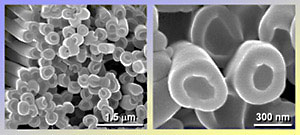| Posted: May 31, 2007 |
Practical protein nanotubes |
|
(Nanowerk News) Chemists in Japan have used a widely available protein and a straightforward technique to make nanotubes that can bind reversibly to oxygen, just like haemoglobin.
|
|
Teruyuki Komatsu from Waseda University, Tokyo, and colleagues first made an artificial hemoprotein by incorporating a zinc-porphyrin into human serum albumin (HSA) ("Artificial hemoprotein nanotubes" – free access article). HSA is a protein found in the plasma of human blood.
|
|
The researchers then used a layer-by-layer deposition technique to make uniform nanotubes composed of the artificial protein. 'The oxygen binding ability of the HSA nanotubes was essentially unaltered compared to the monomeric form in water,' said Komatsu.
|
 |
| The artificial hemoprotein nanotubes are very uniform in size and about 60 micrometres long
|
|
The layer-by-layer technique has been widely employed to make nanotubes from a wide range of materials, but by using biologically active molecules, Komatsu's team have made functional nanotubes that could find use in biomedical applications.
|
|
What's more, Komatsu's ingredients are easy to come by. 'HSA is manufactured on an industrial scale, allowing us to use the HSA nanotubes in practical applications,' said Komatsu.
|
|
Stephen Curry, an expert on proteins at Imperial College London, UK, said, 'it is fascinating to see how knowledge of the properties of such molecules can be exploited in an engineering approach to generate completely new types of materials.'
|
|
Komatsu's team believe that their work will serve as a trigger to create a new class of protein nanotubes.
|

